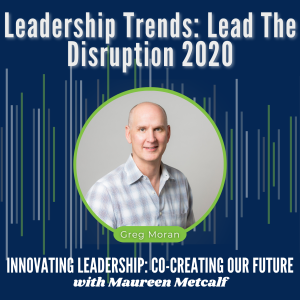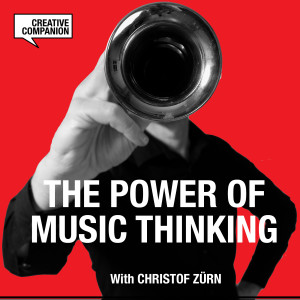

S5-Ep53: Leadership Trends: Lead The Disruption 2020
Guest: Greg Moran
During a time of ongoing organizational disruption, leaders benefit from exploring how the rapid change can serve as a pointer and inspiration to help them envision futures that were not possible as recently as last year. Each disruption opens another door to opportunity across a broad range of industries. Greg Moran joins Maureen for this annual trend discussion that looks at what we think are the most important business drivers to consider over the next three to five years.
Leadership Trends: Lead The Disruption 2020
The following blog is a republish of an article appearing in Forbes written by Maureen Metcalf. It is a companion to the Trends podcast titled Leadership Trends: Lead the Disruption 2020.
To learn more about the 2020 Trends, click here.
During a time of ongoing organizational disruption, I encourage leaders to explore how rapid change can serve as a pointer and inspiration to help them envision futures that were not possible as recently as last year. Each disruption opens another door to opportunity across a broad range of industries.
This annual trend summary looks at what I think are the most important business drivers to consider over the next three to five years.
- Disruption is accelerating. Organizations must continue to monitor trends and disruptions and look for ways to leverage them for strategic advantage. It's often noted that businesses must recognize the importance of disrupting or get disrupted. The question for organizations and their leaders is how to monitor these trends and create an advantage.
One essential tool is the strategic planning process. This process itself looks different now than it did in the past. It provides a necessary structure for leaders to use as they consider current and potential disruptions. The planning process allows leaders to envision the future and develop a business strategy to turn disruption into business advantage.
- Adaptive leadership is required. As companies evolve to respond to disruption, leaders need to elevate the quality of their leadership. The challenges businesses face are adaptive: leaders need to change themselves and their organizations. We are facing problems that we can’t solve with our current thinking. Dr. Ron Heifetz, Harvard, talks about adaptive leadership as a practical leadership framework that helps individuals and organizations adapt to changing environments so they can effectively respond to recurring problems. This research has been considered in the 10 Must-Reads by the Harvard Business Review. I recommend leaders elevate the quality of their leadership rather than build skills.
- Organizations need to innovate who they are — and what they offer. Organizations need to build innovation into their DNA. This means they need to get comfortable updating what they do and how they do it to meet evolving strategic goals. In addition to elevating their leadership, leaders must update the overall systems, processes and cultural beliefs that underpin their organizations.
According to Bloomberg (paywall), “Leaders at some of the world’s largest companies said they plan to abandon the long-held view that shareholders’ interests should come first amid growing public discontent over income inequality and the burgeoning cost of health care and higher education.”
This level of change could mean a significant overhaul of how companies operate. Innovation must be a priority to transform organizations. Effective innovation requires creating clear accountability, assigning people, measuring results and allocating financial resources.
Attracting and retaining the right people will become increasingly difficult with changing job requirements and growing skill gaps. According to IBM Institute for Business Value's Enterprise Guide to Closing the Skills Gap: “Arguably, one of the greatest threats facing organizations today is the talent shortage. Executives recognize the skills gap. They know it’s both real and problematic. But most of their organizations don’t appear to be actively or effectively tackling the issue.”
It goes on to say, “Compounding the issue, new skills requirements continue to emerge, while other skills are becoming obsolete. And it’s all happening quite rapidly.” Organizations must elevate their focus on the impact disruption will have on their workforce. This includes focusing on topics like creating real diversity and inclusion. We can no longer ignore or give minimal effort to the levers that are proven to drive success.
- Digital transformation drives and destroys value. Organizations must become more effective at leveraging digital tools. The lines between the physical, digital and biological worlds are becoming more blurred. Many organizations are now using some form of robotic process automation (RPA), business analytics or artificial intelligence.
Digital transformation is the integration of digital technology into all aspects of a business. It is a trillion-dollar industry, but 70% of all digital transformations fail. The most successful organizations will break the code on implementing these tools effectively and efficiently.
- Human resilience remains critical. As organizations accelerate the pace of change, people are often overloaded with current work and transformation work. The people who make change possible hit a point of diminishing performance that impacts their ability to deliver. Employers must provide work environments that maximize employee performance.
One important factor is creating an environment that ensures employees connect the work they do to their values. Even better, when possible, create opportunities for employees who don’t routinely interact with clients/customers to interact and see their impact. Employees also need to own their personal resilience. They can build resilience by ensuring they are taking care of their physical health, engaging in a mindfulness practice that allows them to observe and manage their thinking and building healthy connections inside and outside of work.
- Sustainability and the human/planet interface are critical. We continue to see an acceleration in climate volatility, high costs to businesses from weather events, lost biodiversity and environmental damage. According to the Associated Press, July 2019 was the hottest month in recorded history. Many parts of South America are burning in unprecedented forest fires. Glacial melt is accelerating, “Over 30 years, suddenly almost all regions started losing mass at the same time,” said researcher Michael Zemp of the University of Zurich. “That’s climate change if you look at the global picture.”
Addressing this trend will require everyone to act. In 2015, the UN created the Sustainable Development Goals, "the blueprint to achieve a better and more sustainable future for all." They address global challenges, including those related to poverty, inequality, climate, environmental degradation, prosperity and peace and justice. The goals interconnect and are designed to leave no one behind. These goals were signed by 193 countries.
Many organizations are making progress. The World Green Building Council supports efforts to convert buildings to energy-efficient standards on a large scale. We see changes like the move toward more local foods across the U.S. and expanding solar power in Nigeria. These actions are a start. As we envision the future, we can elevate the quality of our organization's leaders.
To learn more about the 2020 Trends, click here.
About the Author
Maureen Metcalf, CEO of the Innovative Leadership Institute, is a renowned executive advisor, coach, consultant, author and speaker.
More Episodes
All Episodes>>Create Your Podcast In Minutes
- Full-featured podcast site
- Unlimited storage and bandwidth
- Comprehensive podcast stats
- Distribute to Apple Podcasts, Spotify, and more
- Make money with your podcast












